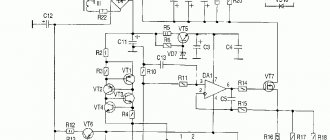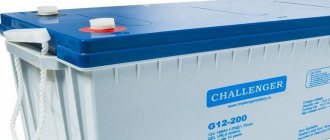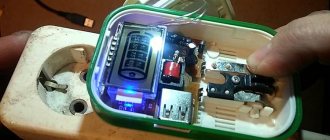Finding internal resistance
It can be found in two ways: calculated or measured. The first path is taken when working with electrical circuits, the second is chosen when working with real devices.
A simple calculation is made using the Ohm's Law formula for a section of a complete circuit:
To find out the current strength, you need to divide the EMF voltage by the sum of the resistances.
Expressing r from here, we get the formula for calculating it:
Where:
- r – internal resistance of the source;
- ε – source emf;
- I – current strength in the complete circuit;
- R is the resistance in the complete circuit.
The complex of measurements of this parameter for this device does not imply direct measurements. The voltages across the load resistance are tested in two current modes: no-load and short-circuit.
Since not any source can withstand even a short-term short circuit, a measurement method without calculations is taken.
The circuit includes an external load resistance in the form of a trimming resistor Rн. The value is set at which the voltage drop across the resistor would be equal to 1/2 U no-load. Then Rн measured by an ohmmeter will correspond to the internal resistance of the source.
How to check the internal resistance of a battery
One of the most important performance criteria is monitoring the internal resistance of the battery. Previously, science had already developed measuring instruments that help monitor the relationship between the product’s capacitance and internal peak current losses.
The assessment is made based on the following factors:
- resistance to alternating current supply;
- under load with DC on;
- when alternating.
However, in such ways it is possible to determine the qualitative condition of the battery, but not its quantitative indicators. Internal resistance alone does not provide a complete answer to how many hours a battery can last in its current state, and even under load. In order to have information about the condition of the device, it is better to purchase an internal resistance tester and take regular measurements. Every year, the resistance inside the battery itself increases by 5%. If this figure exceeds 5%, then you need to pay attention to the load and operating conditions.
Let's see how you can measure the internal resistance of a battery:
- AC supply. This method is the simplest in terms of preparation, but will take 2 hours or more. For it you will have to stock up on a capacitor with a voltmeter, as well as a resistor of a certain value and a digital transformer. The main purpose of the digital display is to establish more accurate values. However, there are factors that do not guarantee a 100% correct measurement result. Electrolysis processes constantly occur in the battery electrolyte, which make their own adjustments.
- Constant load method. This option is used more often than the previous one. It is most in demand in relation to car batteries. To do this, they are completely discharged under the influence of a maximum short-term load. First, measure the voltage with a voltmeter before the discharge, and then after. However, you can find out the exact value using this method only for batteries that are not too worn out.
- Short pulse method. This is one of the recent techniques, which is famous for its maximum accuracy. In this case, the battery does not need to be disconnected or removed from the vehicle. One voltmeter will be enough for testing, and this will not have a negative impact on the performance of the battery.
Determination of the internal resistance of an electrical measuring instrument
To calculate circuit elements when designing measuring instruments, it is necessary to know the data of the pointer instrument itself. The frame resistance of a magnetoelectric microammeter can be measured in a simple and safe way. To do this, you should assemble a circuit consisting of a device whose frame resistance needs to be determined, an adjustable additional resistor Rext; flashlight battery B1, shunt resistor Rsh and switch B1 (Fig. 65).
The resistance of the additional resistor Rext is selected when Rsh is turned off so that the instrument needle deviates to the full scale. Then a shunt resistor of variable resistance Rsh is connected parallel to the device frame, the value of which is selected with such
calculated so that the instrument needle deviates by half the scale. Under this condition, the current in the frame will be equal to the current flowing through Rsh, i.e. Rr - Rsh. After this, Rm can be turned off and its value measured using a measuring bridge or an ohmmeter.
In a similar way, the internal resistance of the measuring generator, as well as the output stage of the low-frequency amplifier, can be determined. A lamp voltmeter must be connected to the output of the unloaded device, the readings of which are recorded when there is no load at the output. Then a resistance of such a magnitude is connected to the output of the generator (amplifier) that the voltmeter readings are halved. The internal resistance of the generator at a given frequency will be exactly equal to the resistance value of the connected resistor.
Rice. 65. Method for measuring the internal resistance of an electrical measuring device
Source
High internal resistance
Piezoelectric sensors, condenser microphones, and other pulse sources have increased internal impedance. To effectively use such devices, you need to properly match the signal reading circuit. If coordination fails, losses are inevitable.
Important! Successful voltage matching is obtained when using a device with a higher input impedance than that of the signal source to pick up a signal. In the case of a high-impedance source, a buffer amplifier is used to read the signal.
Resistance measurement
This value is conditional. It changes depending on the degree of charge of the battery, the load size, and temperatures. That is why, when making accurate calculations regarding the battery, it is customary to use not the value of internal resistance, but the so-called discharge curves.
However, there are situations when you need to find out the internal resistance of a car battery. For these purposes, you can use an incandescent lamp from a headlight.
This option will give a completely accurate result. For example, this could be a halogen lamp with a power of 60 watts.
We recommend: Battery pinout and laptop battery controller circuit
A parallel connection is made to the battery of a voltmeter and the above-mentioned lamp.
Next you need to remember the voltage value. Then the lamp turns off. Naturally, after this the tension will increase. If the latter increased by no more than 0.02 volts, then the battery is in satisfactory condition. That is, internal R is no more than 0.01 Ohm. Finding out this parameter yourself is not difficult at all. The main thing is not to use LED lamps. The entire procedure will take a few minutes.
The influence of internal resistance on the properties of a two-terminal network
The higher it is, the less power the source produces when a load is connected. The power in the load can be determined using the formula:
Where:
- E – EMF voltage;
- R – load resistance;
- r – active internal resistance of a two-terminal network.
The formula is applicable to two-terminal networks that do not release energy.
For your information. When the internal resistance of the two-terminal network approaches the load resistance, the power transfer reaches a maximum.
Related factors
There is practically no difference between the performance of sponge lead and the negative electrode grid. However, the resistance of lead peroxide is 10,000 times greater than that of the positive electrode array on which it is applied. The electrodes of the device themselves can be made in different ways, which causes differences in performance. May vary, including:
- quality of electrical contact of coating and gratings;
- electrode design;
- lattice design;
- the presence of alloying components in the battery.
The R of separators is affected by changes in porosity and thickness. For an electrolyte, it depends on its temperature and concentration. If the electrolyte freezes, the indicator will reach infinity.
It must be said that whatever the internal resistance of the battery, it will depend on the frequency.











